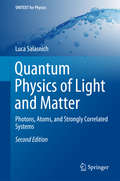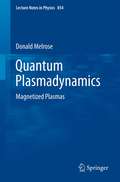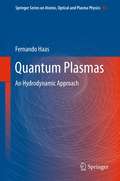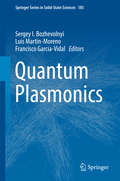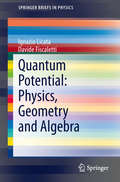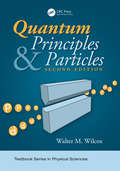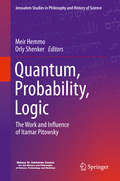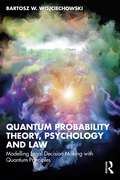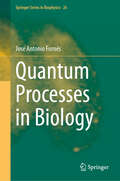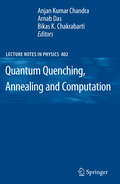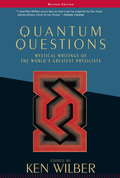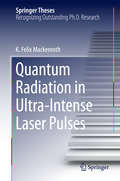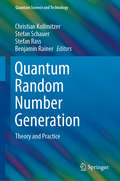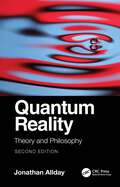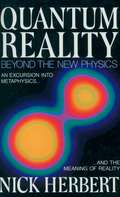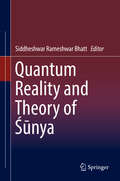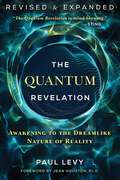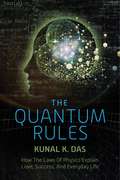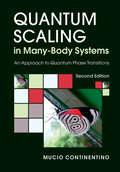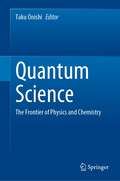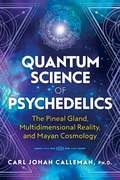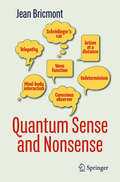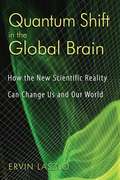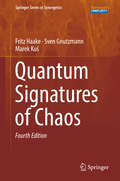- Table View
- List View
Quantum Physics of Light and Matter
by Luca SalasnichThis compact but exhaustive textbook, now in its significantly revised and expanded second edition, provides an essential introduction to the field quantization of light and matter with applications to atomic physics and strongly correlated systems. Following an initial review of the origins of special relativity and quantum mechanics, individual chapters are devoted to the second quantization of the electromagnetic field and the consequences of light field quantization for the description of electromagnetic transitions. The spin of the electron is then analyzed, with particular attention to its derivation from the Dirac equation. Subsequent topics include the effects of external electric and magnetic fields on the atomic spectra and the properties of systems composed of many interacting identical particles. The book also provides a detailed explanation of the second quantization of the non-relativistic matter field, i. e. , the Schr#65533;dinger field, which offers a powerful tool for the investigation of many-body problems, and of atomic quantum optics and entanglement. Finally, two new chapters introduce the finite-temperature functional integration of bosonic and fermionic fields for the study of macroscopic quantum phenomena: superfluidity and superconductivity. Several solved problems are included at the end of each chapter, helping readers put into practice all that they have learned.
Quantum Plasmadynamics
by Donald MelroseQuantum Plasmadynamics is a synthesis of the kinetic theory of plasmas and quantum electrodynamics (QED). In this volume, the approach applied to unmagnetized plasmas in volume 1 is generalized to magnetized plasmas. First, a covariant version of nonquantum kinetic theory is formulated for single-particle (emission and scattering) processes and the collective-medium response. The relativistic quantum treatment is based on solutions of Dirac's equation for an electron in a magnetostatic field, and single-particle processes are treated using a magnetized version of QED. The response of an electron gas is derived by generalizing the derivation of the response of the magnetized vacuum.
Quantum Plasmas
by Fernando HaasThis book provides an overview of the basic concepts and new methods in the emerging scientific area known as quantum plasmas. In the near future, quantum effects in plasmas will be unavoidable, particularly in high density scenarios such as those in the next-generation intense laser-solid density plasma experiment or in compact astrophysics objects. Currently, plasmas are in the forefront of many intriguing questions around the transition from microscopic to macroscopic modeling of charged particle systems. Quantum Plasmas: an Hydrodynamic Approach is devoted to the quantum hydrodynamic model paradigm, which, unlike straight quantum kinetic theory, is much more amenable to investigate the nonlinear realm of quantum plasmas. The reader will have a step-by-step construction of the quantum hydrodynamic method applied to plasmas. The book is intended for specialists in classical plasma physics interested in methods of quantum plasma theory, as well as scientists interested in common aspects of two major areas of knowledge: plasma and quantum theory. In these chapters, the quantum hydrodynamic model for plasmas, which has continuously evolved over the past decade, will be summarized to include both the development and applications of the method.
Quantum Plasmonics
by Sergey I. Bozhevolnyi Luis Martin-Moreno Francisco Garcia-VidalThis book presents the latest results of quantum properties of light in the nanostructured environment supporting surface plasmons, including waveguide quantum electrodynamics, quantum emitters, strong-coupling phenomena and lasing in plasmonic structures. Different approaches are described for controlling the emission and propagation of light with extreme light confinement and field enhancement provided by surface plasmons. Recent progress is reviewed in both experimental and theoretical investigations within quantum plasmonics, elucidating the fundamental physical phenomena involved and discussing the realization of quantum-controlled devices, including single-photon sources, transistors and ultra-compact circuitry at the nanoscale.
Quantum Potential: Physics, Geometry and Algebra
by Ignazio Licata Davide FiscalettiRecently the interest in Bohm realist interpretation of quantum mechanics has grown. The important advantage of this approach lies in the possibility to introduce non-locality ab initio, and not as an "unexpected host". In this book the authors give a detailed analysis of quantum potential, the non-locality term and its role in quantum cosmology and information. The different approaches to the quantum potential are analysed, starting from the original attempt to introduce a realism of particles trajectories (influenced by de Broglie's pilot wave) to the recent dynamic interpretation provided by Goldstein, Durr, Tumulka and Zanghì, and the geometrodynamic picture, with suggestion about quantum gravity. Finally we focus on the algebraic reading of Hiley and Birkbeck school, that analyse the meaning of the non-local structure of the world, bringing important consequences for the space, time and information concepts.
Quantum Principles and Particles, Second Edition (Textbook Series in Physical Sciences)
by Walter WilcoxThis textbook offers a unique introduction to quantum mechanics progressing gradually from elementary quantum mechanics to aspects of particle physics. It presents the microscopic world by analysis of the simplest possible quantum mechanical system (spin 1/2). A special feature is the author’s use of visual aids known as process diagrams, which show how amplitudes for quantum mechanical processes are computed. The second edition includes a new chapter and problems on time-dependent processes, in addition to new material on quantum computing and improved illustrations. Key Features: Provides a completely updated text with expanded contents. Includes a brand new chapter on time-dependent processes and expanded coverage of recent developments in particle physics. Emphasizes a visual approach employing process diagrams and utilizing new figures. Incorporates quantum information theory in a new appendix, with other helpful supplements on notation, lattice models, weak flavor mixing, and numerical simulations.
Quantum, Probability, Logic: The Work and Influence of Itamar Pitowsky (Jerusalem Studies in Philosophy and History of Science)
by Meir Hemmo Orly ShenkerThis volume provides a broad perspective on the state of the art in the philosophy and conceptual foundations of quantum mechanics. Its essays take their starting point in the work and influence of Itamar Pitowsky, who has greatly influenced our understanding of what is characteristically non-classical about quantum probabilities and quantum logic, and this serves as a vantage point from which they reflect on key ongoing debates in the field. Readers will find a definitive and multi-faceted description of the major open questions in the foundations of quantum mechanics today, including: Is quantum mechanics a new theory of (contextual) probability? Should the quantum state be interpreted objectively or subjectively? How should probability be understood in the Everett interpretation of quantum mechanics? What are the limits of the physical implementation of computation? The impact of this volume goes beyond the exposition of Pitowsky’s influence: it provides a unique collection of essays by leading thinkers containing profound reflections on the field.Chapter 1. Classical logic, classical probability, and quantum mechanics (Samson Abramsky) Chapter 2. Why Scientific Realists Should Reject the Second Dogma of Quantum Mechanic (Valia Allori) Chapter 3. Unscrambling Subjective and Epistemic Probabilities (Guido Bacciagaluppi) Chapter 4. Wigner’s Friend as a Rational Agent (Veronika Baumann, Časlav Brukner) Chapter 5. Pitowsky's Epistemic Interpretation of Quantum Mechanics and the PBR Theorem (Yemima Ben-Menahem) Chapter 6. On the Mathematical Constitution and Explanation of Physical Facts (Joseph Berkovitz) Chapter 7. Everettian probabilities, the Deutsch-Wallace theorem and the Principal Principle (Harvey R. Brown, Gal Ben Porath) Chapter 8. ‘Two Dogmas’ Redu (Jeffrey Bub) Chapter 9. Physical Computability Theses (B. Jack Copeland, Oron Shagrir) Chapter 10. Agents in Healey’s Pragmatist Quantum Theory: A Comparison with Pitowsky’s Approach to Quantum Mechanics (Mauro Dorato) Chapter 11. Quantum Mechanics As a Theory of Observables and States and, Thereby, As a Theory of Probability (John Earman, Laura Ruetsche) Chapter 12. The Measurement Problem and two Dogmas about Quantum Mechanic (Laura Felline) Chapter 13. There Is More Than One Way to Skin a Cat: Quantum Information Principles In a Finite World(Amit Hagar) Chapter 14. Is Quantum Mechanics a New Theory of Probability? (Richard Healey) Chapter 15. Quantum Mechanics as a Theory of Probability (Meir Hemmo, Orly Shenker) Chapter 16. On the Three Types of Bell's Inequalities (Gábor Hofer-Szabó) Chapter 17. On the Descriptive Power of Probability Logic (Ehud Hrushovski) Chapter 18. The Argument against Quantum Computers (Gil Kalai) Chapter 19. Why a Relativistic Quantum Mechanical World Must be Indeterministic (Avi Levy, Meir Hemmo) Chapter 20. Subjectivists about Quantum Probabilities Should be Realists about Quantum States (Wayne C. Myrvold) Chapter 21. The Relativistic Einstein-Podolsky-Rosen Argument (Michael Redhead) Chapter 22. What price statistical independence? How Einstein missed the photon.(Simon Saunders) Chapter 23. How (Maximally) Contextual is Quantum Mechanics? (Andrew W. Simmons) Chapter 24. Roots and (Re)Sources of Value (In)Definiteness Versus Contextuality (Karl Svozil) Chapter 25: Schrödinger’s Reaction to the EPR Paper (Jos Uffink) Chapter 26. Derivations of the Born Rule (Lev Vaidman) Chapter 27. Dynamical States and the Conventionality of (Non-) Classicality (Alexander Wilce).
Quantum Probability Theory, Psychology and Law: Modelling Legal Decision Making with Quantum Principles
by Bartosz W. WojciechowskiThis book provides the first consideration of quantum principles in legal decision making. It shows how quantum probability theory can be applied to psychology and law to deepen our understanding of psychological and legal issues, suggesting a paradigm shift in the study of these areas. Written as an introduction to quantum probability theory for non-physicists, the book offers an accessible summary of how psychology can be applied to quantum phenomena for human decision making. It introduces psychologists and lawyers to fresh conceptual frameworks, including classical probability theory, classical statistics, data mining and quantum theory. Wojciechowski shows how quantum theory and concepts can be transferred to psychological research models, and can help to resolve previously unexplained psychological phenomena, influence scientific views, undermine traditional foundations of the legal system and result in the development of new research directions. Studies conducted by the author are used to show how problems facing legal decision making can be addressed in a completely new light with the application of quantum probability theory. This cutting-edge and innovative book will be of great interest to graduate students and researchers in the fields of forensic psychology and legal decision making, as well as legal professionals and legal scholars.
Quantum Processes in Biology (Springer Series in Biophysics #26)
by José Antonio FornésIn recent years, extensive research on stochastic processes such as neuron networks, molecular motors, dynamics models, anomalous diffusion, and disordered media has led to the development of various methods for applying the Classical and Quantum Smoluchowski Equation to these phenomena. This book focuses on presenting the solution to the Fokker-Planck equation using the Crank-Nicholson formalism. This method is particularly effective for handling systems with numerous interactions, requiring vector and matrix-oriented approaches suitable for implementation in Matlab. Among the topics treated in the book are: Dynamics of protons in DNA, Photosynthesis and the quantum mechanochemical model, Entanglement, coherence and decoherence, Excitons in the Fenna-Mathews-Olson complex, and Energy exchange between cells. The author has made an incredible work in facilitating the understanding of these complex topics. This book includes a brief and clear explanation of the Quantum theory and also includes code to build useful software to use in research environments. This volume is particularly helpful for graduate students in physics and biology interested in understanding biological processes with the use of quantum physics tools.
Quantum Processes, Systems, and Information
by Benjamin Schumacher Michael D. WestmorelandA new and exciting approach to the basics of quantum theory, this undergraduate textbook contains extensive discussions of conceptual puzzles and over 800 exercises and problems. Beginning with three elementary 'qubit' systems, the book develops the formalism of quantum theory, addresses questions of measurement and distinguishability, and explores the dynamics of quantum systems. In addition to the standard topics covered in other textbooks, it also covers communication and measurement, quantum entanglement, entropy and thermodynamics, and quantum information processing. This textbook gives a broad view of quantum theory by emphasizing dynamical evolution, and exploring conceptual and foundational issues. It focuses on contemporary topics, including measurement, time evolution, open systems, quantum entanglement, and the role of information.
Quantum Quenching, Annealing and Computation
by Bikas K. Chakrabarti Arnab Das Anjan Kumar ChandraThe process of realizing the ground state of some typical (frustrated) quantum many-body systems, starting from the 'disordered' or excited states, can formally be mapped onto the search of solutions for computationally hard problems. The dynamics through quantum critical points are especially crucial in the context of such computational optimization problems and have been investigated intensively in recent times. Several successful methods are now well-established, and this volume compiles a collection of introductory reviews on such developments and related aspects. Written by well known experts, these lectures concentrate on quantum phase transitions and their dynamics as the transition or critical points are crossed. Both the quenching and annealing dynamics are extensively covered. The style has been kept as tutorial as possible in order to make this volume a suitable reference for young researchers joining this exciting and burgeoning field of research.
Quantum Questions: Mystical Writings of the World's Great Physicists
by Ken WilberHere is a collection of writings that bridges the gap between science and religion. Quantum Questions collects the mystical writings of each of the major physicists involved in the discovery of quantum physics and relativity, including Albert Einstein, Werner Heisenberg, and Max Planck. The selections are written in nontechnical language and will be of interest to scientists and nonscientists alike.
Quantum Radiation in Ultra-Intense Laser Pulses
by K. Felix MackenrothScientific advances and several technical breakthroughs have led to a remarkable increase in available laser intensities over the past decades. In available ultra-intense laser fields, photon fluxes may become so high that free charge carriers interact coherently with several of the field's photons. In this thesis such nonlinear interactions are investigated for the prime example of radiation emission by electrons scattered from intense laser pulses of arbitrary temporal structure. To this end, nonlinear quantum field theory is employed taking the interaction with the laser into account exactly. After an in-depth introduction to classical particle dynamics as well as quantum field theory in nonlinearly intense laser fields the emission of one and two photons is explicitly analyzed. The results are then translated to viable technical applications, such as a scheme for the determination of the carrier-envelope phase of ultra-intense laser pulses and a proposal for detecting the strongly suppressed two-photon signal.
Quantum Random Number Generation: Theory and Practice (Quantum Science and Technology)
by Stefan Rass Stefan Schauer Christian Kollmitzer Benjamin RainerThis book provides an overview of state-of-the-art implementations of quantum random number generators (QRNGs), and especially examines their relation to classical statistical randomness models and numerical techniques for computing random numbers. The reader – who ideally has a background in classical statistics, computer science, or cryptography – is introduced to the world of quantum bits step by step, and explicit relations between QRNGs and their classical counterparts are identified along the way. Random number generation is a major pillar of cryptography. Capitalizing on the randomness inherent in quantum phenomena is a rapidly evolving branch of quantum cryptography with countless applications for the future. The value of quantum randomness for cryptographic purposes is empirically demonstrated in statistical evaluations of QRNGs’ performance compared to classical techniques for true and pseudorandom number generation. The book then provides an overview of technical implementations of QRNGs, before a concluding discussion of major achievements and remaining obstacles in the field rounds out the coverage, while also opening the door for future research directions.
Quantum Reality: Theory and Philosophy
by Jonathan AlldayAs probably the most successful scientific theory ever created, quantum theory has profoundly changed our view of the world and extended the limits of our knowledge, impacting both the theoretical interpretation of a tremendous range of phenomena and the practical development of a host of technological breakthroughs. Yet for all its success, quantum theory remains utterly baffling. Quantum Reality: Theory and Philosophy, Second Edition cuts through much of the confusion to provide readers with an exploration of quantum theory that is as authoritatively comprehensive as it is intriguingly comprehensible. The book has been fully updated throughout to include the latest results in quantum entanglement, the theory and practical applications of quantum computing, quantum cosmology and quantum gravity. Needing little more than a school level physics and mathematics background, this volume requires only an interest in understanding how quantum theory came to be and the myriad ways it both explains how our universe functions and extends the reach of human knowledge. Written by well-known physics author and teacher Dr. Jonathan Allday, this highly engaging work: • Presents a thorough grounding in the theoretical machinery of quantum physics • Offers a whistle-stop tour through the early part of the 20th century when the founding fathers of quantum theory forever altered the frontiers of human thought • Provides an example-filled interpretation of the theory, its applications, and its pinnacle in quantum field theory (QFT), so crucial in shaping ideas about the nature of reality • Separates fact from speculation regarding quantum physics’ ability to provide a starting point for philosophical queries into ultimate understanding and the limits of science The world beneath the one that we experience with our senses is profoundly mysterious, and while we may never completely unravel that mystery, quantum theory allows us to come closer than ever to understanding where the science leaves off and the mystery begins. Quantum Reality: Theory and Philosophy, Second Edition makes that understanding accessible to anyone possessing a quest for knowledge and a sense of awe.
Quantum Reality: Beyond the New Physics
by Nick HerbertThis clearly explained layman's introduction to quantum physics is an accessible excursion into metaphysics and the meaning of reality. Herbert exposes the quantum world and the scientific and philosophical controversy about its interpretation.From the Trade Paperback edition.
Quantum Reality and Theory of Śūnya
by Siddheshwar Rameshwar BhattThe book deals with expounding the nature of Reality as it is understood in contemporary times in Quantum Physics. It also explains the classical Indian theory of Śūnya in its diverse facets. Thereafter it undertakes comparison between the two which is an area of great topical interest. It is a cross-disciplinary study by erudite Indian and western scholars between traditional Indian knowledge system and contemporary researches in Physical sciences. It points out how the theory of ‘Śūnyatā has many seminal ideas and theories in common with contemporary Quantum Physics. The learned authors have tried to dissolve the “mysteries” of Quantum Physics and resolved its “weird paradoxes” with the help of theory of Śūnyatā. The issue of non-separability or entanglement has been approached with the help of the Buddhist theory of Pratītyasamutpāda. The paradoxical situation of “wave-particle duality” has been explained with the help of Upaniṣadic theory of complementarity of the two opposites. The measurement problem represented by “Schrodinger’s cat” has been dealt with by resorting to two forms of the calculation of probabilities. Some writers have argued for Śūnyatā-like non-essentialist position to understand quantum reality. To make sense of quantum theory some papers provide a happy symbiosis of technical understanding and personal meditative experience by drawing multifarious parallels. This book will be of interest to philosophically inclined physicists and philosophers with interest in quantum mechanics.
The Quantum Revelation: Awakening to the Dreamlike Nature of Reality
by Paul Levy• Shows how the revelations emerging from quantum physics can wake us up from the disempowering spell of the scientific materialist worldview and help dispel the collective madness that has befallen our species• Explains for readers with no physics background why quantum physics is, in the words of Albert Einstein, so &“uncommonly important&” that &“it should be everyone&’s concern&”• Shows how quantum physics can help us awaken to the malleable, dreamlike nature of reality, a realization that unlocks the creative spirit within usExplaining the world-transforming effects of quantum physics, Paul Levy shows how discoveries in this field—widely considered the greatest in the history of science—can wake us up from the disempowering spell of the reductionist, materialist worldview, thereby helping to dispel the collective madness that has befallen our species. He explains how quantum physics helps us to consciously realize our vast evolutionary potential and awaken us to the malleable, dreamlike nature of reality, a realization that unlocks the creative spirit hidden within our own minds. In a radical synthesis of quantum physics with spirituality, psychology, lucid dreaming, and alchemy, Levy contemplates the deeper philosophical and metaphysical underpinnings of quantum mechanics, exploring what it means that quantum physics has empirically proven that there is no such thing as &“objective reality&” and how we are active participants in creating our experience of reality, whether we realize it or not.Revealing the quantum nature of our world and ourselves, The Quantum Revelation shows how quantum physics has become a modern-day spiritual path for awakening and expanding consciousness with particular relevance for the challenging times we are living through.
The Quantum Rules: How the Laws of Physics Explain Love, Success, and Everyday Life
by Kunal K. DasA New York Times Best Seller!Here is a book to lead you through the fascinating intersections of life and physics with humor and intelligence.Find out how the laws of physics define every aspect of our lives and society, from human nature and relationships to geopolitical issues like financial markets, globalization and immigration. The Quantum Rules is a different kind of physics book, as easy to read as a novel and directly relevant for everyday life issues that affect us all. It is not meant to dazzle you with unproven speculations that have no bearing on your life. Rather, The Quantum Rules will familiarize you with the important and established laws at the heart of physics, in a way never done before - by showing how the defining patterns of our lives, our behavior and our society already follow similar rules.Never took an interest in science before? No problem! you will still understand everything and find plenty to relate to. A scientist or a science junkie? You will find a different perspective on things you may already know. Best of all, you will discover how to have meaningful conversations about physics in a way that won’t make eyes glaze over, and in which all can gladly participate.The Quantum Rules also does something you would never expect from a book on physics - it makes you laugh, often. Its new and original take on established natural laws injects plenty of dry humor into this serious subject, by using life to explain physics and in turn using physics to understand life.
Quantum Scaling In Many-body Systems
by Mucio ContinentinoThis book on quantum phase transitions has been written by one of the pioneers in the application of scaling ideas to many-body systems OCo a new and exciting subject that has relevance to many areas of condensed matter and theoretical physics. One of the few books on the subject, it emphasizes strongly correlated electronic systems. Although dealing with complex problems in statistical mechanics, it does not lose sight of the experiments and the actual physical systems which motivate the theoretical work. The book starts by presenting the scaling theory of quantum critical phenomena. Critical exponents for different systems are calculated using both the momentum space and real space renormalization group approaches. The former is developed without the use of Feynman diagrams, allowing nonspecialists to fully appreciate the underlying physics of this method. The case of heavy fermions as an example of systems close to a zero temperature phase transition is presented and discussed in detail. This is also the case of non-Fermi liquid behavior associated with a quantum critical point. MetalOCoinsulator transitions are discussed within the scaling approach. The book ends with a discussion on first order quantum phase transitions, in particular those which occur due to a fluctuation-induced mechanism. Contents: Scaling Theory of Quantum Critical Phenomena; Landau and Gaussian Theories; Renormalization Group: The A-Expansion; Quantum Phase Transitions; Real Space Renormalization Group Approach; Heavy Fermions; A Microscopic Model for Heavy Fermions; MetalOCoInsulator Transitions; Density-Driven MetalOCoInsulator Transitions; Mott Transitions; The Nonlinear Sigma Model; Fluctuation-Induced Quantum Phase Transitions. Readership: Graduate students, lecturers and researchers in condensed matter physics. "
Quantum Science: The Frontier of Physics and Chemistry
by Taku OnishiThis book focuses on recent topics of quantum science in both physics and chemistry. Until now, quantum science has not been fully discussed from the interdisciplinary vantage points of both physics and chemistry. This book, however, is written not only for theoretical physicists and chemists, but also for experimentalists in the fields of physical chemistry and condensed matter physics, as collaboration and interplay between construction of quantum theory, and experimentation has become more important. Tips for starting new types of research projects will be found in an understanding of cutting-edge quantum science. In Part I, quantum electronic structures are explained in cases of strongly correlated copper oxides and heavy elements. In Part II, quantum molecular dynamics is investigated by computational approaches and molecular beam experiments. In Part III, after lithium problem in big bang nucleosynthesis scenario is considered using supersymmetric standard model, quantum theories in atomic and molecular systems are reviewed. Finally, in Part IV, the development of quantum computational method is introduced.
Quantum Science of Psychedelics: The Pineal Gland, Multidimensional Reality, and Mayan Cosmology
by Carl Johan CallemanA groundbreaking exploration of how psychedelics and quantum science are vital to understanding the evolution of consciousness and reality • Explains why altered states of consciousness exist, how they work, and why psychedelics have the effects that they do • Describes how quantum waves, rather than the DNA molecule, have been the driving force behind biological and historical evolution • Explains how psychedelics interact with the human mind to create altered states that may further the continued evolution of consciousness In this groundbreaking book, Carl Johan Calleman reveals the quantum science of the Maya, a science lost to the modern world that explains the phenomenology of psychedelics and altered states of consciousness. The ancient Maya had a sophisticated understanding of the multidimensional nature of reality and the forces that drive the evolution of consciousness. Calleman explains how quantum waves, illustrated by the Mayan Calendar, emanate from the center of the universe and activate new phases in the evolution of consciousness through holographic resonance, which alters the dualities of the human mind. For example, the 5th Wave, which dominated in Paleolithic times and evolved human consciousness above that of animals, brought a chaotic floating state reminiscent of the psychedelic or shamanic state, and the recent 8th Wave brought the digital revolution. The 9th Wave, which began in 2011, offers the potential for individual development of higher consciousness and healing if we can synchronize ourselves with its positive holograms. This multidimensional perspective explains why altered states of consciousness exist and how they work. Calleman describes the role of the pineal gland for the human mind, how it controls our state of consciousness and how it can connect us to the cosmic Tree of Life. He shows that the mind is a &“reducing valve&” that normally limits our experience of cosmic consciousness but that this can be reversed through altered states. As Calleman concludes, psychedelics like ayahuasca and DMT not only give rise to extraordinary mystical and cosmic experiences and enable access to healing states, but they also are important for harmoniously synchronizing humanity with the 9th Wave to further the evolution of consciousness.
Quantum Sense and Nonsense
by Jean BricmontPermeated by the author's delightful humor, this little book explains, with nearly no mathematics, the main conceptual issues associated with quantum mechanics: The issue of determinism. Does quantum mechanics signify the end of a deterministic word-view? The role of the human subject or of the "observer" in science. Since Copernicus, science has increasingly tended to dethrone Man from his formerly held special position in the Universe. But quantum mechanics, with its emphasis on the notion of observation, may once more have given a central role to the human subject. The issue of locality. Does quantum mechanics imply that instantaneous actions at a distance exist in Nature? In these pages the author offers a variety of views and answers - bad as well as good - to these questions. The reader will be both entertained and enlightened by Jean Bricmont's clear and incisive arguments.
Quantum Shift in the Global Brain: How the New Scientific Reality Can Change Us and Our World
by Ervin LaszloThe shift from scientific materialism to a multidimensional worldview in harmony with the world’s great spiritual traditions• Articulates humanity’s critical choice--to be the last decade of an outgoing, obsolete world, or the first of a new and viable one• Presents a new “reality map” to guide us through the environmental, scientific, and geopolitical upheavals we are experiencingOur world is in a Macroshift. The reality we are experiencing today is a substantially new reality--climate change, global corporations, industrialized agriculture--challenging us to change with our rapidly changing world, lest we perish. In this book, Ervin Laszlo presents a new “reality map” to guide us through the world shifts we are experiencing--the problems, opportunities, and challenges we face individually as well as collectively--in order to help us understand what we must do during this time of great transition. Science’s cutting edge now views reality as broader, as multiple universes arising in a possibly infinite meta-universe, as well as deeper, extending into dimensions at the subatomic level. Laszlo shows that aspects of human experience that had previously been consigned to the domain of intuition and speculation are now being explored with scientific rigor and urgency. There has been a shift in the materialistic scientific view of reality toward the multidimensional worldview of multiple interconnected realities long known by the world’s great spiritual traditions. By understanding the interconnectedness of our changing world as well as our changing “map” of the world, we can navigate with insight, wisdom, and confidence.
Quantum Signatures of Chaos (Springer Series in Synergetics #Vol. 54)
by Fritz Haake Sven Gnutzmann Marek KuśThis by now classic text provides an excellent introduction to and survey of the still-expanding field of quantum chaos. For this long-awaited fourth edition, the original text has been thoroughly modernized. <P><P> The topics include a brief introduction to classical Hamiltonian chaos, a detailed exploration of the quantum aspects of nonlinear dynamics, quantum criteria used to distinguish regular and irregular motion, and antiunitary (generalized time reversal) and unitary symmetries. The standard Wigner-Dyson symmetry classes, as well as the non-standard ones introduced by Altland and Zirnbauer, are investigated and illustrated with numerous examples. Random matrix theory is presented in terms of both classic methods and the supersymmetric sigma model. The power of the latter method is revealed by applications outside random-matrix theory, such as to quantum localization, quantum graphs, and universal spectral fluctuations of individual chaotic dynamics. The equivalence of the sigma model and Gutzwiller’s semiclassical periodic-orbit theory is demonstrated. Last but not least, the quantum mechanics of dissipative chaotic systems are also briefly described. <P><P> Each chapter is accompanied by a selection of problems that will help newcomers test and deepen their understanding, and gain a firm command of the methods presented.
